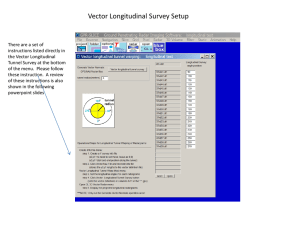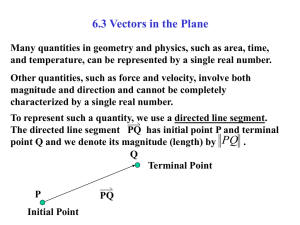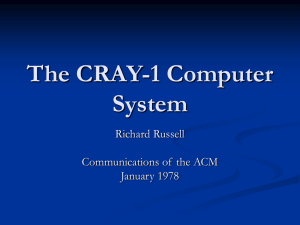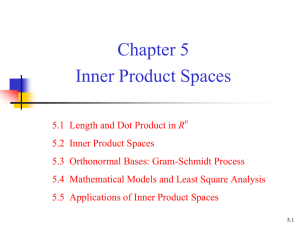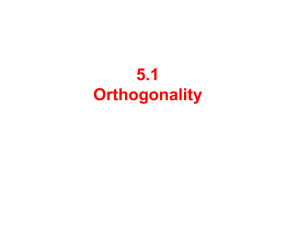Document
advertisement
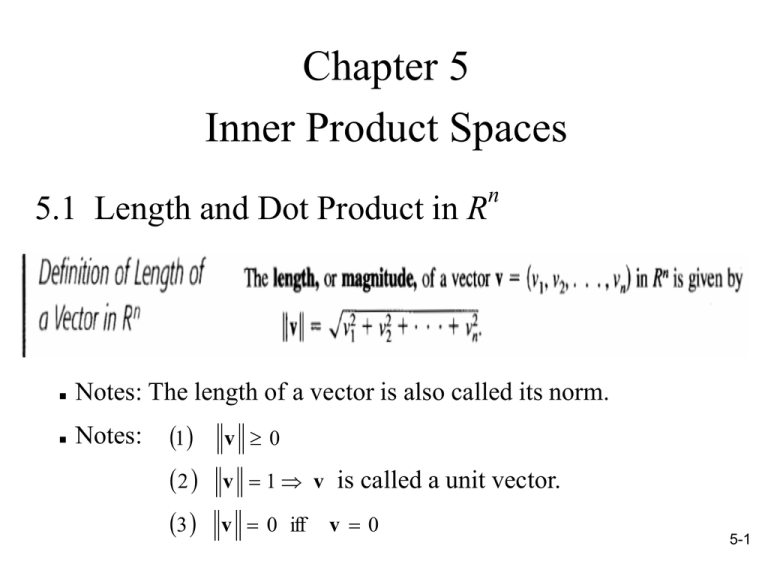
Chapter 5
Inner Product Spaces
n
5.1 Length and Dot Product in R
Notes: The length of a vector is also called its norm.
Notes:
1
v 0
2
v 1 v
3
v 0 iff
is called a unit vector.
v 0
5-1
5-2
5-3
• Notes:
The process of finding the unit vector in the direction of v is
called normalizing the vector v.
• A standard unit vector in Rn:
e 1 , e 2 , , e n 1,0 , ,0 , 0 ,1, ,0 , 0 ,0 , ,1
Ex:
the standard unit vector in R2: i , j 1, 0 , 0 ,1
the standard unit vector in R3:
i ,
j, k
1, 0 , 0 , 0 ,1, 0 , 0 , 0 ,1
5-4
Notes: (Properties of distance)
(1)
d (u , v ) 0
(2)
d (u , v ) 0
(3)
d (u , v ) d ( v , u )
if and only if
u v
5-5
5-6
• Euclidean n-space:
Rn was defined to be the set of all order n-tuples of real
numbers. When Rn is combined with the standard
operations of vector addition, scalar multiplication,
vector length, and the dot product, the resulting vector
space is called Euclidean n-space.
5-7
Dot product and matrix multiplication:
u1
u2
u
u n
v1
v2
v
v n
u v u v [u 1
T
u2
(A vector u ( u1 , u 2 , , u n ) in Rn
is represented as an n×1 column matrix)
v1
v2
[u v u v u v ]
un ]
1 1
2 2
n n
v n
5-8
Note: The angle between the zero vector and another vector
is not defined.
5-9
Note: The vector 0 is said to be orthogonal to every vector.
5-10
Note:
Equality occurs in the triangle inequality if and only if
the vectors u and v have the same direction.
5-11
5.2 Inner Product Spaces
• Note:
u v dot product ( Euclidean
n
inner product for R )
u , v general inner product for vector
space V
5-12
Note:
A vector space V with an inner product is called an inner
product space.
Vector space:
V ,
,
Inner product space:
V ,
, , ,
5-13
5-14
Note: || u || 2 〈 u , u 〉
5-15
Properties of norm:
(1) || u || 0
(2) || u || 0 if and only if
u0
(3) || c u || | c | || u ||
5-16
Properties of distance:
(1) d ( u , v ) 0
(2) d ( u , v ) 0 if and only if u v
(3) d ( u , v ) d ( v , u )
5-17
Note:
If v is a init vector, then 〈 v , v 〉 || v || 2 1.
The formula for the orthogonal projection of u onto v
takes the following simpler form.
proj v u u , v v
5-18
5-19
5.3 Orthonormal Bases: Gram-Schmidt Process
S v 1 , v 2 , , v n V
S v 1 , v 2 , , v n V
vi, v j 0
1
vi, v j
0
i j
i j
Note:
If S is a basis, then it is called an orthogonal basis or an
orthonormal basis.
5-20
5-21
5-22
5-23
5-24
5-25
5.4 Mathematical Models and Least Squares
Analysis
5-26
Orthogonal complement of W:
Let W be a subspace of an inner product space V.
(a) A vector u in V is said to orthogonal to W,
if u is orthogonal to every vector in W.
(b) The set of all vectors in V that are orthogonal to W is
called the orthogonal complement of W.
W
{v V | v , w 0 , w W }
W
Notes:
(1)
0
V
(read “ W perp”)
(2) V
0
5-27
• Notes:
W is a subspace
(1) W
is a subspace
(2) W W
(3)
of V
of V
0
(W ) W
Ex:
If V R , W x axis
2
Then (1) W
y - axis
(2) W W
(3) (W
is a subspace
of R
2
( 0 , 0 )
) W
5-28
5-29
5-30
5-31
• Notes:
(1) Among all the scalar multiples of a vector u, the
orthogonal projection of v onto u is the one that is
closest to v.
(2) Among all the vectors in the subspace W, the vector
proj W v is the closest vector to v.
5-32
• The four fundamental subspaces of the matrix A:
N(A): nullspace of A
N(AT): nullspace of AT
R(A): column space of A
R(AT): column space of AT
5-33
5-34
Least squares problem:
Ax b
m n n 1 m 1
(A system of linear equations)
(1) When the system is consistent, we can use the Gaussian
elimination with back-substitution to solve for x
(2) When the system is inconsistent, how to find the “best
possible” solution of the system. That is, the value of x for
which the difference between Ax and b is small.
Least squares solution:
Given a system Ax = b of m linear equations in n unknowns,
the least squares problem is to find a vector x in Rn that
minimizes
Ax b
with respect to the Euclidean inner
product on Rn. Such a vector is called a least squares
solution of Ax = b.
5-35
A M
x R
mn
n
A x CS ( A ) ( CS A is a subspace
m
of R )
W CS ( A )
Let A xˆ proj W b
( b A xˆ ) CS ( A )
b A xˆ ( CS ( A ))
NS ( A )
A ( b A xˆ ) 0
i.e.
A A xˆ A b
(the normal equations of the least squares
problem Ax = b)
5-36
• Note:
The problem of finding the least squares solution of A x b
is equal to he problem of finding an exact solution of the
associated normal system A A xˆ A b .
Thm:
For any linear system A x b , the associated normal system
A A xˆ A b
is consistent, and all solutions of the normal system are least
squares solution of Ax = b. Moreover, if W is the column space
of A, and x is any least squares solution of Ax = b, then the
orthogonal projection of b on W is
proj W b A x
5-37
• Thm:
If A is an m×n matrix with linearly independent column vectors,
then for every m×1 matrix b, the linear system Ax = b has a
unique least squares solution. This solution is given by
x ( A A)
1
A b
Moreover, if W is the column space of A, then the orthogonal
projection of b on W is
proj W b A x A ( A A )
1
A b
5-38
5.5 Applications of Inner Product Spaces
5-39
5-40
• Note: C[a, b] is the inner product space of all continuous
functions on [a, b].
5-41
5-42



